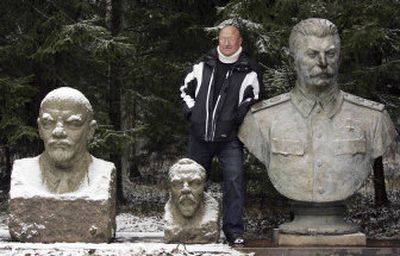‘Stalin’s world’

GRUTAS, Lithuania – A Soviet prison camp may not sound like the ideal place for a good time. Even less so in a country that was occupied by the Red Army for half a century. Yet Grutas Park, a quirky theme park dotted with relics of Lithuania’s communist past, has become a major tourist attraction in this former Soviet republic.
Now celebrating its fifth anniversary, the park – popularly known as “Stalin’s World” – each year welcomes hundreds of thousands of visitors who traipse along two miles of wooden walkways resembling those in Siberian prison camps to get from one exhibition to the next.
Statues of Vladimir Lenin, Josef Stalin and other Soviet leaders glower at visitors, and the barbed wire fences and guard towers surrounding the park help give it the feel of a Soviet gulag.
Today, though, the park attracts thousands to cheer and jeer symbols that used to instill fear and outrage in people in this former Soviet republic, which, along with Baltic neighbors Latvia and Estonia, regained its independence during the 1991 Soviet collapse.
“Why I am doing this? It’s my gift to future generations,” said park founder and owner Viliumas Malinauskas, a Lithuanian millionaire. “People can come here and joke about these grim statues. This means that Lithuania is no longer afraid of communism.”
Malinauskas, 63, sunk $2 million into Grutas Park after amassing a fortune exporting mushrooms to the West.
The park, which opened in April 2001, spans 50 acres of drained swamp about a half-hour drive from the capital, Vilnius. Next to the sculptures, monuments and paintings charged with communist ideology are a merry-go-round, a restaurant and a small zoo.
The park receives about 200,000 visitors annually – a number Malinauskas said was increasing by 20,000 per year – and employs 80 people. It isn’t profitable, he said, but it isn’t losing money, either.
“Children just love this place. Busloads from schools come to Grutas every day from all over Lithuania,” Malinauskas said as he watched a group of schoolchildren walk past him.
He even entertained thoughts of constructing a railroad track connecting Grutas to the capital city – complete with cattle cars like those that took the hundreds of thousands of Lithuanians deported by the Soviets to Siberia – to carry visitors to his park. But he dismissed the idea as too complicated and expensive.
Danute Juodiene, a 45-year-old history teacher from the city of Kaunas, said he finds something new every time he visits.
“This time I found two new Lenin statues and new birds at their zoo,” Juodiene said.
But not everyone is amused by the park. Some have bitterly criticized it as an affront to the those deported or killed during the Soviet occupation, which started during World War II.
“Malinauskas, a former farmer, does not care that these forests where Grutas park was built once served as shelter for Lithuanian freedom fighters against Soviet occupants,” said Juozas Galdikas, a former Parliament member.
“He does not care about painful history of Lithuania. What is purpose of this park? To laugh at our pain?”
Galdikas led a group of lawmakers who tried, but failed, to shut the park down – which prompted Malinauskas to erect wooden statues of them alongside the Soviet leaders.
“Those who are still afraid of shadows of the past deserve to stand here,” Malinauskas said.